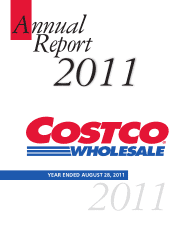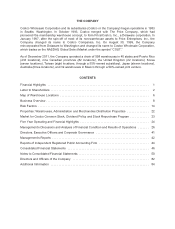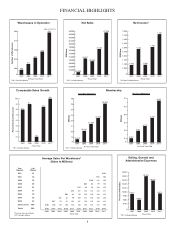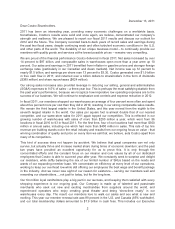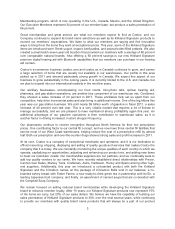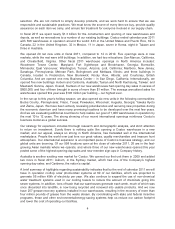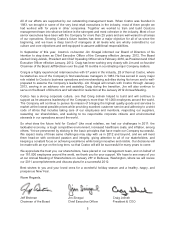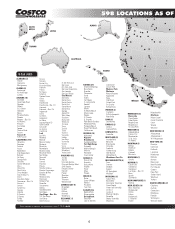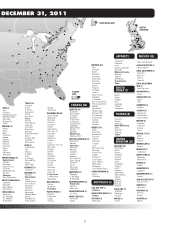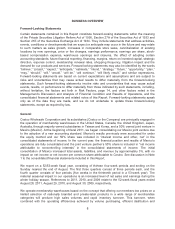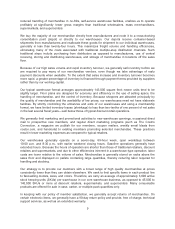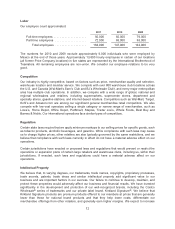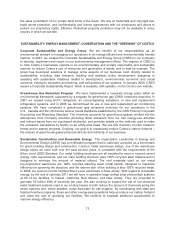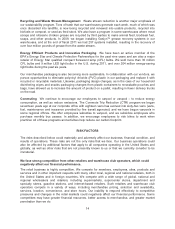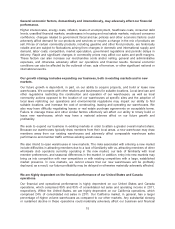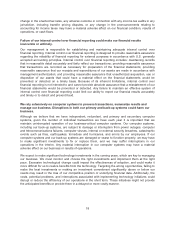Costco 2011 Annual Report Download - page 11
Download and view the complete annual report
Please find page 11 of the 2011 Costco annual report below. You can navigate through the pages in the report by either clicking on the pages listed below, or by using the keyword search tool below to find specific information within the annual report.reduced handling of merchandise in no-frills, self-service warehouse facilities, enables us to operate
profitably at significantly lower gross margins than traditional wholesalers, mass merchandisers,
supermarkets, and supercenters.
We buy the majority of our merchandise directly from manufacturers and route it to a cross-docking
consolidation point (depot) or directly to our warehouses. Our depots receive container-based
shipments from manufacturers and reallocate these goods for shipment to our individual warehouses,
generally in less than twenty-four hours. This maximizes freight volume and handling efficiencies,
eliminating many of the costs associated with traditional multiple-step distribution channels. Such
traditional steps include purchasing from distributors as opposed to manufacturers, use of central
receiving, storing and distributing warehouses, and storage of merchandise in locations off the sales
floor.
Because of our high sales volume and rapid inventory turnover, we generally sell inventory before we
are required to pay many of our merchandise vendors, even though we take advantage of early
payment discounts when available. To the extent that sales increase and inventory turnover becomes
more rapid, a greater percentage of inventory is financed through payment terms provided by suppliers
rather than by our working capital.
Our typical warehouse format averages approximately 143,000 square feet; newer units tend to be
slightly larger. Floor plans are designed for economy and efficiency in the use of selling space, the
handling of merchandise, and the control of inventory. Because shoppers are attracted principally by
the quality of merchandise and the availability of low prices, our warehouses need not have elaborate
facilities. By strictly controlling the entrances and exits of our warehouses and using a membership
format, we have limited inventory losses (shrinkage) to less than two-tenths of one percent of net sales
in the last several fiscal years—well below those of typical discount retail operations.
We generally limit marketing and promotional activities to new warehouse openings, occasional direct
mail to prospective new members, and regular direct marketing programs (such as The Costco
Connection, a magazine we publish for our members, coupon mailers, weekly email blasts from
costco.com, and handouts) to existing members promoting selected merchandise. These practices
result in lower marketing expenses as compared to typical retailers.
Our warehouses generally operate on a seven-day, 69-hour week, open weekdays between
10:00 a.m. and 8:30 p.m., with earlier weekend closing hours. Gasoline operations generally have
extended hours. Because the hours of operation are shorter than those of traditional retailers, discount
retailers and supermarkets, and due to other efficiencies inherent in a warehouse-type operation, labor
costs are lower relative to the volume of sales. Merchandise is generally stored on racks above the
sales floor and displayed on pallets containing large quantities, thereby reducing labor required for
handling and stocking.
Our strategy is to provide our members with a broad range of high quality merchandise at prices
consistently lower than they can obtain elsewhere. We seek to limit specific items in each product line
to fast-selling models, sizes, and colors. Therefore, we carry an average of approximately 3,600 active
stock keeping units (SKUs) per warehouse in our core warehouse business, as opposed to 45,000 to
140,000 SKUs or more at discount retailers, supermarkets, and supercenters. Many consumable
products are offered for sale in case, carton, or multiple-pack quantities only.
In keeping with our policy of member satisfaction, we generally accept returns of merchandise. On
certain electronic items, we generally have a 90-day return policy and provide, free of charge, technical
support services, as well as an extended warranty.
9

